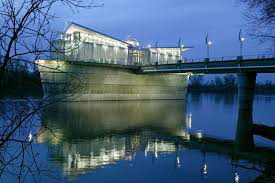INTAKES AND THEIR TYPES
Intakes are the structures used for admitting water from the surface sources (i.c., river. reservoir or hike) and conveying it further to the treatment plant. Generally, an intake is a masonry or concrete structure with an aim of providing relatively clean water, free from pollution, sand and objectionable floating material.
Site for location of intake:
Intake work should provide purer water so that is treatment may be less exhaustive
1. Heavy water currents should not strike the intake directly Intake should be located at such a situation where sufficient quantity of water remains
2. available under all the circumstances. • Ste should be well connected by good type or roads
3. Site should be such that intake should be in a position to provide more water, if requied to do so.
4. Site should not be located in navigation channels, the reason being water in such channels are generally polluted.
5. During floods, the intake should not be submerged by the flooding waters.
6. As far as possible, the site should be located on the upstream side of the town / city
7. The intake should be so located that good foundation conditions are prevalent and the possibility of scouring is minimal
8. The site should be selected in such a manner that there is ample scope for further
Types of intakes ;
1. Submerged intake:
Submerged intake is the one which is constructed entirely under water. Such an intake is commonly used to obtain supply from a lake.
An exposed intake is in the form of a well or tower constructed near the bank of a river, or in some cases even away from the river banks Exposed intakes are more common due to case in its operation. A wet intake is that type of intake tower in which the water level is practically the same as the water level of the sources of supply.
Such an intake is sometimes known as jack well and is most commonly used. In the case of dry intake, however, there is no water in the water tower. Water enters through entry point directly into the conveying pipes. The dry tower is simply used for the operation of valves etc.
2. River intake:
A river intake is located to the upstream of the city so that pollution is minimized. They are either located sufficiently inside the river so that demands of water are met with in all the seasons of the year, or they may be located near the river bank where a sufficient depth of water is available.
Sometimes, an approach channel is constructed and water is led to the intake tower. If the water level in the river is low, a weir may be constructed across it to raise - the water level and divert it to the intake tower.
3. Reservoir intake:
When the flow in the river is not guaranteed throughout the year a dam is constructed across it to store water in the reservoir so formed.
The reservoir intakes are practically similar to the river intake, except that these are located near the upstream face of the dam where maximum depth of water is available.
3. Lake Intake:
Lake intakes are similar to reservor intakes if the depth of the water near the banks is reasonable.
If however, the depth of the water near the banks is shallow, and greater depth is available only at its centre, a submerged intake is provided.
4. Canal intake:
Sometimes, the source of water supply to a small town may be an irrigation canal passing near the town. The canal intake essentially consists of concrete or masonry intake chamber of rectangular shape, admitting water through a coarse screen.
A fine screen is provided over the bell mouth entry of the outlet pipe. The bell mouth entry is located below the expected low water level in the canal.






Comments
Post a Comment